
- Jaydon Blue gets drafted despite his inexperience: Blue only started five games in his college career, but showed enough promise to get drafted in the fifth round.
- The Dallas Cowboys‘ backfield is wide open: The Cowboys haven’t made a significant investment in any running back on the roster, which could lead to anyone becoming the starter, and any kind of rotation.
- Subscribe to PFF+: Get access to player grades, PFF Premium Stats, fantasy football rankings, all of the PFF fantasy draft research tools and more!
Estimated Reading Time: 5 minutes

PFF’s Fantasy Football Player Profile series delivers the most in-depth fantasy football analysis available for the 2025 season.
Using PFF’s exclusive data, we evaluate player performance, competition for touches and how teammates and coaching staffs will impact each player’s fantasy football outlook.
Last updated: 7:15 a.m. Monday, May 5
Click here for more draft tools:
NFL Draft Big Board | Mock Draft Simulator | NCAA Premium Stats
2025 PFF Draft Guide | Mock Draft Hub | Prospect Data Profiles
Draft Position Rankings
Player performance
Jaydon Blue spent his three seasons at Texas as a backup running back. In 2022, he was behind Bijan Robinson, Roschon Johnson, Keilan Robinson and Jonathon Brooks, who all made their way to the NFL. He reached starter status to begin the 2024 season, but in Week 7, he ran 11 times for 34 yards while Quintrevion Wisner ran 13 times for 114 yards, leading to Wisner taking over for the rest of the season. Blue continued to see significant playing time despite being the backup.
Throughout his three-year career, he only ran the ball 215 times. His only noteworthy stat as a runner was his avoided tackle rate. His stock rose when he and Wisner were both given significant opportunities in the playoff game against Clemson. He ran 14 times for 146 yards and two touchdowns.
Where he stood out in 2024 was as a receiver. He ran 15 routes per game, but was targeted on over one-fourth of his routes, which is exceptionally high for a college running back. Understandably, all of his cumulative and rate stats were similarly high. His receiving grade wasn’t very high, primarily due to five dropped passes and a fumble. He was a clear top receiving back from the draft class when eliminating all negatively graded plays by receivers.
Blue is an undersized running back at 5-foot-9 and 196 pounds, but a fast one. His 4.38-second 40-yard dash time is among the best from a running back, and his PFF tracking data backs that up.

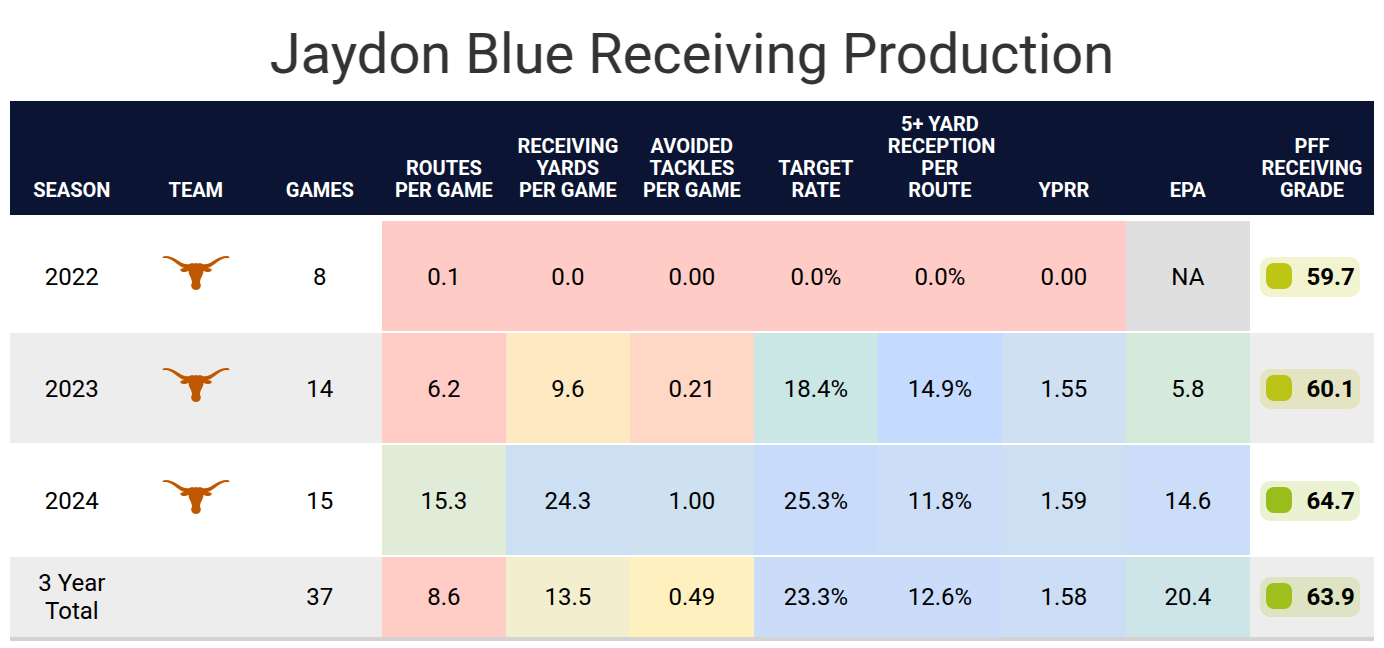
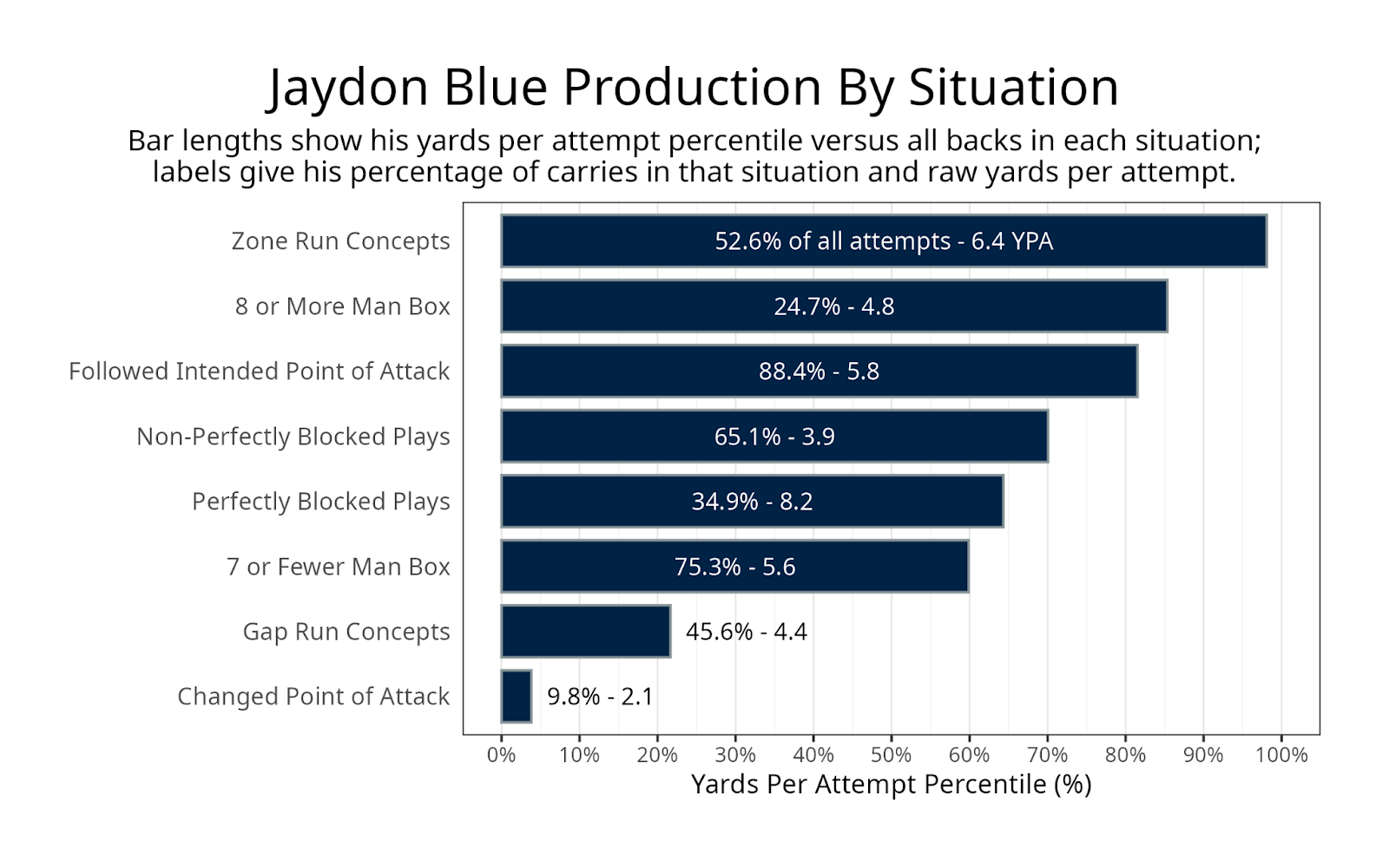
Projected role
Blue lands with the Dallas Cowboys with a completely new backfield for 2025. They moved on from Rico Dowdle, Ezekiel Elliott and Dalvin Cook, and added veterans Javonte Williams and Miles Sanders and drafted Blue and Mafah.
This should be a wide-open competition. Williams has the most recent experience as a runner. He received double-digit carries in six games in the first nine weeks, but then his role was toned down. Sanders has graded better as a runner, but that was largely from his 2022 season with the Philadelphia Eagles. During his two seasons with the Carolina Panthers, he averaged 3.5 yards per carry. Phil Mafah had both more experience and graded better as a runner among the two college players, but Blue was drafted earlier. Any one of these four players could lead the team in rushing, and it shouldn’t be a surprise.
On passing downs, the competition is likely between Javonte Williams and Jaydon Blue, considering Sanders and Mafah’s grades on passing downs and low yards per route run. It’s worth noting that fullback Hunter Luepke was the Cowboys’ third-down back last season, entirely for his pass blocking. Cowboys running backs had nine receptions on third downs last season, which was tied for the fourth-fewest.
It’s also possible the Cowboys bring in another running back at some point of time. Williams’ contract is for one year and $3 million, while Sanders’ contract is for one year and $1.2 million. The Cowboys may move on from all of their current running backs by next season, as even fifth-round running backs aren’t guaranteed to make a 53-man roster in their second season. Multiple veterans remain available in free agency, and other players could be available from other crowded backfields.
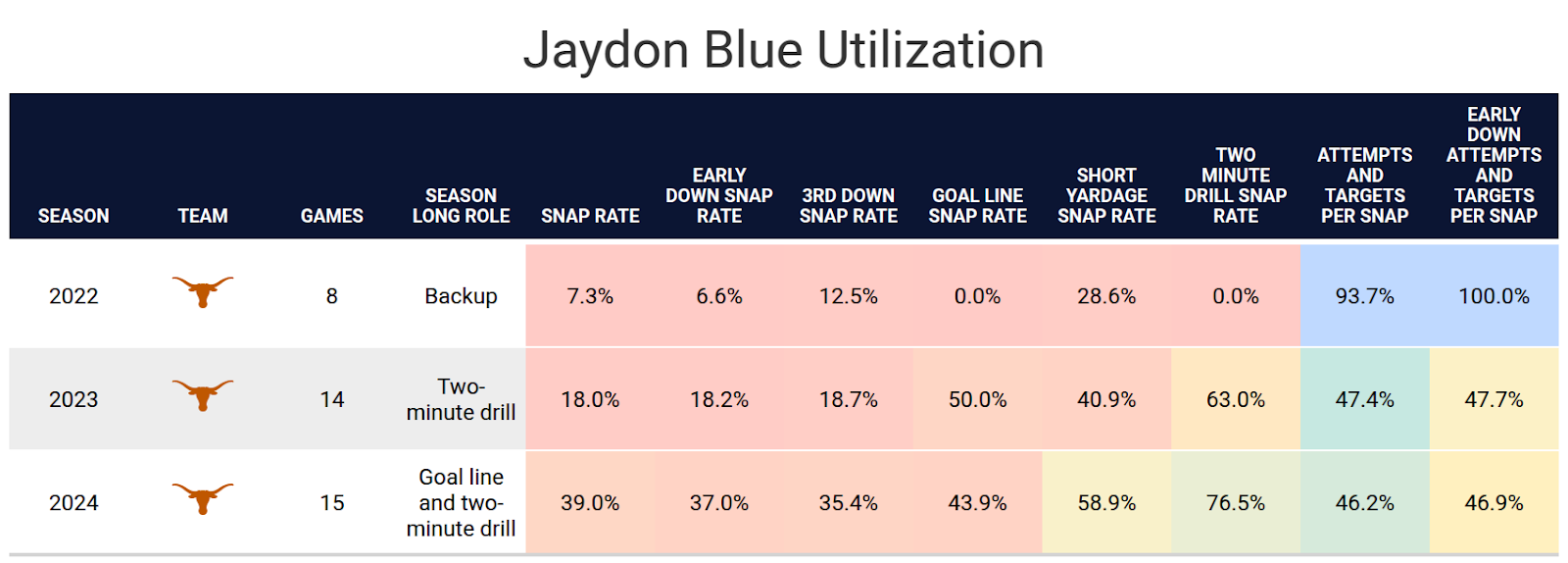
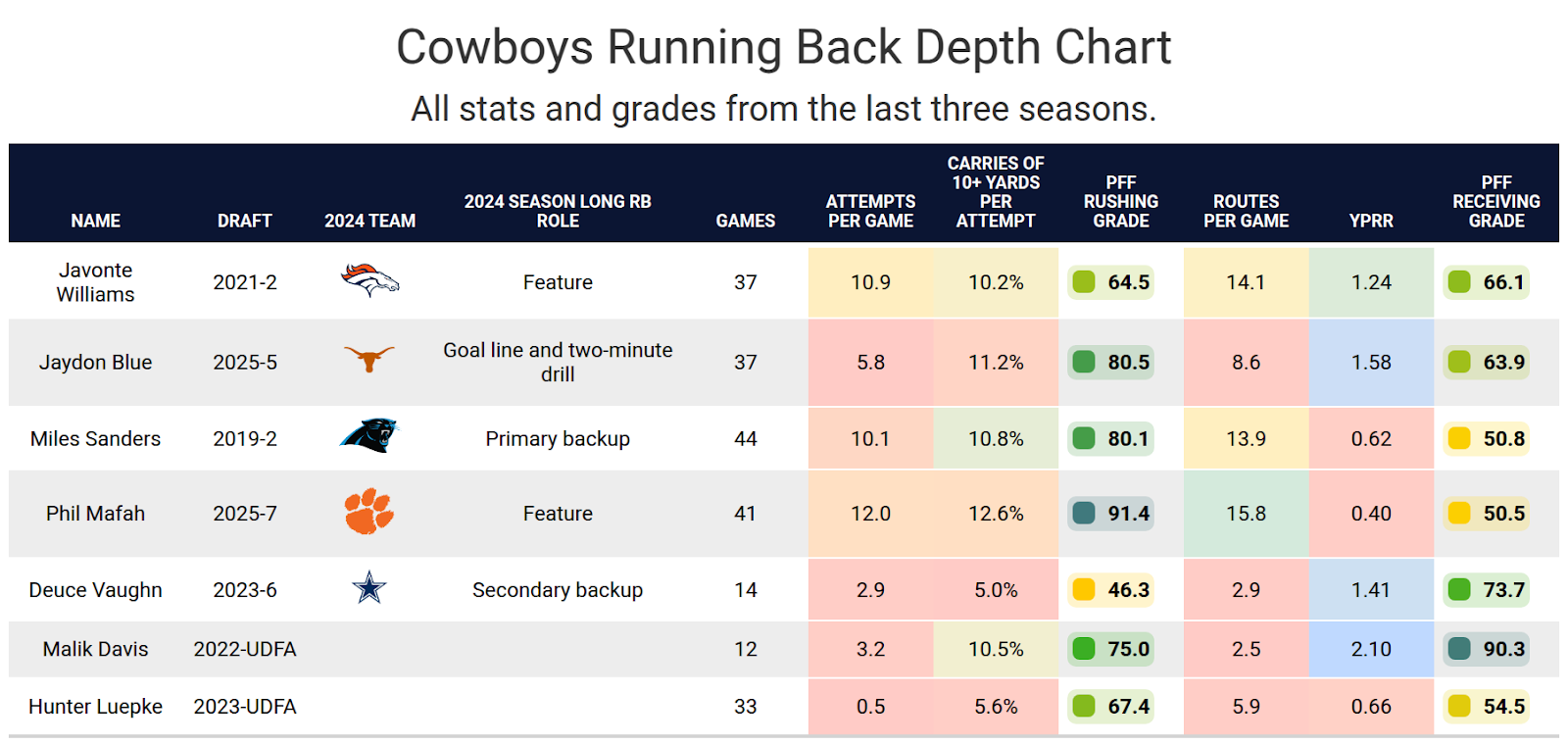
Impact of teammates
The Cowboys elevated Brian Schottenheimer to head coach. He has extensive experience as an offensive coordinator for the New York Jets from 2006-2011, the St. Louis Rams from 2012-2014, the Seattle Seahawks from 2018-2020 and the Cowboys from 2023-2024. His backfield rotations have been inconsistent from one year to the next. He’s had one season at each spot with one clear running back, but most years have featured one clear rusher and one clear receiver. Other years, due to injuries or benchings, they’ve had a three or four-man backfield, with no one playing over 500 offensive snaps. Unless someone has a fantastic training camp, we could be destined for a crowded backfield.
The Cowboys have invested heavily in their offensive line after Tyron Smith‘s departure last offseason and Zack Martin‘s retirement this offseason. Veterans Tyler Smith and Terence Steele have become players to build around. Tyler Guyton and Cooper Beebe had mixed results as rookies, while Tyler Booker was the third first-round pick in four years. The line was ultimately below average last season, but it has sky-high potential if the younger players can live up to the draft capital invested in them.
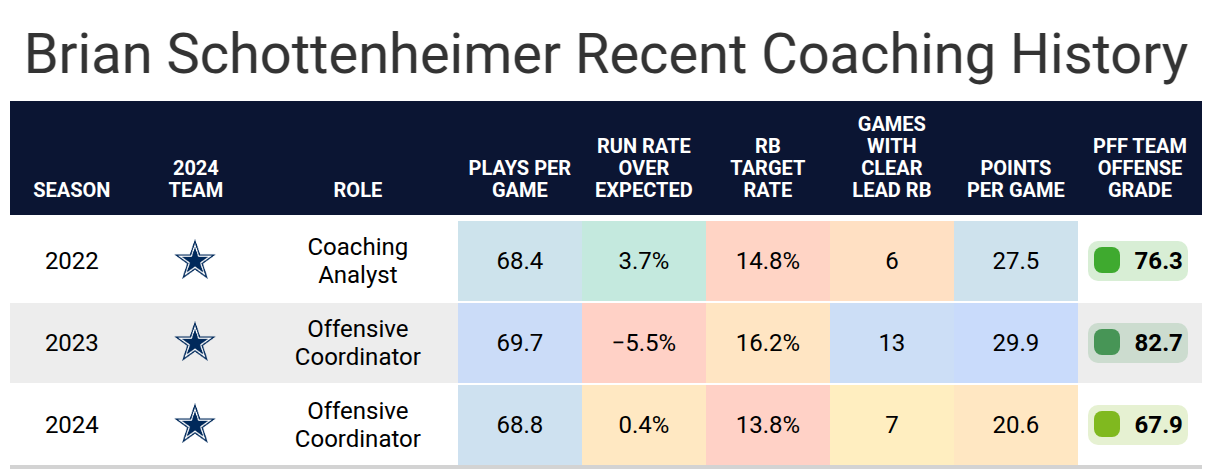
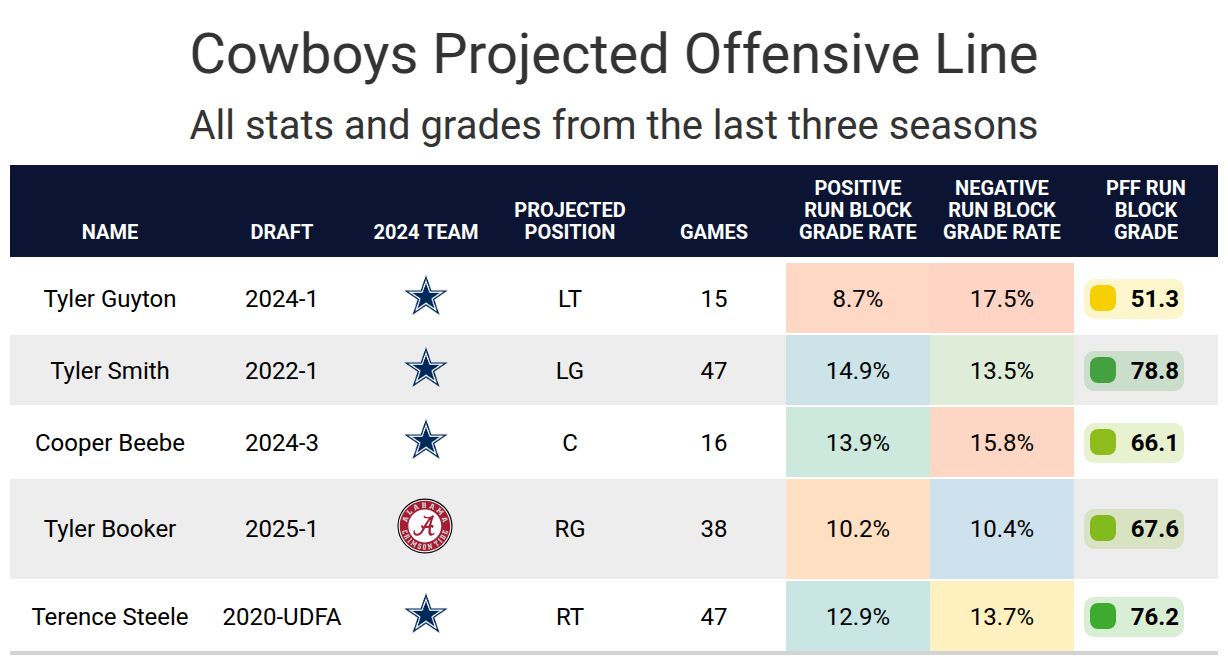
Bottom line
Blue is a relatively inexperienced running back entering a wide-open competition for the Cowboys’ backfield. Blue may be a full-time starter at some point this season, but it’s also possible he ends up fourth on the depth chart. At this point, all of the Dallas running backs are nothing more than late-round dart throws.
Footnotes
- Statistics in tables and charts were chosen based on their ability to predict future fantasy performance on a per-game or per-opportunity basis or to describe the player relative to others at the same position.
- “Opportunities” are defined as passing dropbacks, rushing attempts and routes run as a receiver.
- Numbers are provided either by season or based on the past three years. For rookies, only college statistics are included. For non-rookies, only NFL statistics are considered, regardless of whether they played in college within the previous three years.
- As college competition is easier than NFL competition, most rookies are likely to see a decline from their historical numbers.
- Only FBS data is considered for college players and comparisons.
- Kneel-downs are removed from rushing data to provide cleaner quarterback rushing rate statistics.
- The table colors in this article range from blue (indicating good/high) to red (indicating bad/low).
- All percentiles and color codings compare the given player to others with a high sample of opportunities. Generally, the cutoff is one-third of the possible opportunities in the sample. If a player does not meet the threshold, they are still included in the comparison, though their results may appear better or worse than expected due to the smaller, less predictive sample size.
- Information on utilization classifications and their importance can be found here for running backs, wide receivers and tight ends.
This news was originally published on this post .






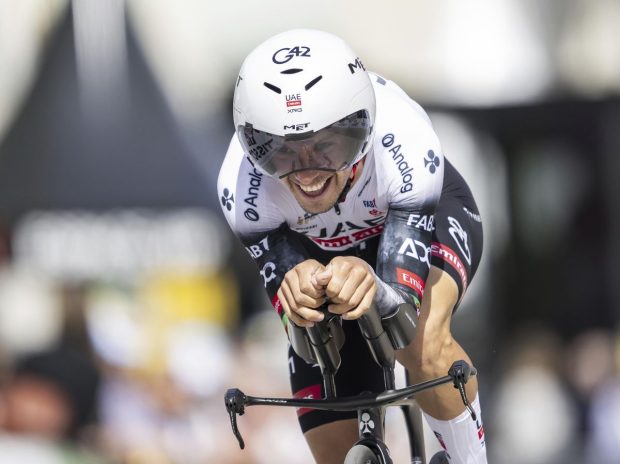



Be the first to leave a comment